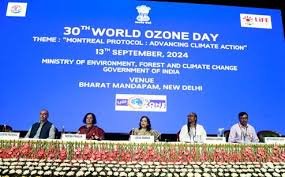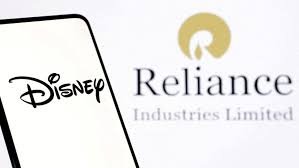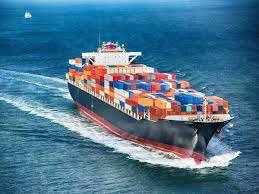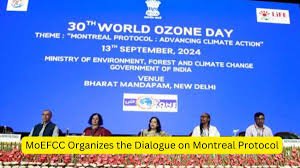Dialogue on Montreal Protocol Organized by MoEFCC
Introduction to the Dialogue
The Ministry of Environment, Forest and Climate Change (MoEFCC) recently organized a significant dialogue on the Montreal Protocol. This event aimed to reinforce global commitments to the protocol, which focuses on phasing out substances that deplete the ozone layer. The dialogue brought together key stakeholders, including government officials, environmental experts, and industry representatives, to discuss progress and future strategies in combating ozone depletion.
Key Discussions and Outcomes
During the dialogue, various topics were covered, including the impact of the Montreal Protocol on global environmental health, the challenges faced in its implementation, and the innovative solutions proposed to address these challenges. A central theme was the need for enhanced cooperation among nations to ensure the successful reduction of ozone-depleting substances (ODS). The discussions also highlighted the role of emerging technologies and policy measures in achieving these goals.
The event underscored the importance of maintaining momentum in the global effort to protect the ozone layer, emphasizing that continued vigilance and action are necessary to meet the protocol’s targets. The dialogue also featured sessions on the economic and social benefits of adhering to the Montreal Protocol, including improved public health and environmental quality.
Future Steps and Commitments
In conclusion, the dialogue on the Montreal Protocol organized by MoEFCC was a crucial step in reaffirming global commitment to environmental protection. The discussions set the stage for future initiatives and collaborations aimed at strengthening the protocol’s implementation. The MoEFCC’s role in facilitating this dialogue reflects its ongoing commitment to addressing global environmental challenges and promoting sustainable practices.

Why This News is Important
Global Environmental Impact
The Montreal Protocol is a landmark international agreement designed to protect the ozone layer by phasing out substances responsible for ozone depletion. The dialogue organized by MoEFCC highlights the continued global commitment to this essential environmental agreement. The ozone layer plays a critical role in shielding the Earth from harmful ultraviolet (UV) radiation, which can lead to increased rates of skin cancer, cataracts, and other health issues. By focusing on the protocol, nations can work together to mitigate these risks and safeguard public health.
Enhancing International Cooperation
The dialogue underscores the importance of international cooperation in addressing environmental issues. The Montreal Protocol is often cited as one of the most successful environmental agreements due to the collaborative efforts of its signatories. The discussions at the MoEFCC event reinforce the need for ongoing global partnerships and coordinated action to ensure the protocol’s objectives are met. This collaborative approach is vital for tackling complex environmental challenges that transcend national borders.
Addressing Emerging Challenges
The dialogue also addressed the need to adapt to new challenges in the implementation of the Montreal Protocol. As new technologies and industry practices evolve, it is crucial to continuously update and refine strategies for ozone layer protection. The event provided a platform for discussing these emerging issues and developing innovative solutions to address them. This proactive approach is essential for maintaining the effectiveness of the protocol and ensuring continued progress in environmental protection.
Historical Context
Origins of the Montreal Protocol
The Montreal Protocol, adopted in 1987, was a groundbreaking international agreement aimed at protecting the ozone layer by phasing out the production and use of ozone-depleting substances. The protocol was negotiated in response to growing scientific evidence of the depletion of the ozone layer and its harmful effects on human health and the environment. It marked a significant milestone in global environmental governance and set a precedent for future international agreements on environmental issues.
Achievements and Challenges
Since its adoption, the Montreal Protocol has achieved significant success in reducing the levels of ozone-depleting substances in the atmosphere. This success has led to the gradual recovery of the ozone layer, demonstrating the effectiveness of coordinated international action. However, challenges remain, including the need to address illegal trade in banned substances and adapt to new environmental threats. The dialogue organized by MoEFCC reflects ongoing efforts to address these challenges and ensure the continued success of the protocol.
Key Takeaways from “Dialogue on Montreal Protocol”
| # | Key Takeaway |
|---|---|
| 1 | The Montreal Protocol is crucial for protecting the ozone layer from harmful substances. |
| 2 | The dialogue emphasized the need for enhanced international cooperation in implementing the protocol. |
| 3 | Emerging technologies and policy measures are key to addressing new challenges in ozone layer protection. |
| 4 | The event highlighted the economic and social benefits of adhering to the Montreal Protocol. |
| 5 | Continued global commitment and proactive strategies are essential for the protocol’s success. |
Important FAQs for Students from this News
1. What is the Montreal Protocol?
The Montreal Protocol is an international treaty designed to protect the ozone layer by phasing out substances that deplete it. Adopted in 1987, it has been widely regarded as one of the most successful environmental agreements due to its global impact on reducing ozone-depleting substances (ODS).
2. Why is the dialogue on the Montreal Protocol important?
The dialogue is crucial for maintaining and enhancing global commitments to the Montreal Protocol. It allows stakeholders to discuss progress, address challenges, and explore new strategies and technologies for effectively implementing the protocol’s goals. Such discussions ensure continued international cooperation and innovation in environmental protection.
3. What are the main goals of the Montreal Protocol?
The main goals of the Montreal Protocol are to reduce and eventually eliminate the production and use of ozone-depleting substances. This helps to protect the ozone layer, which in turn shields the Earth from harmful ultraviolet (UV) radiation, thereby reducing health risks and environmental damage.
4. How has the Montreal Protocol impacted global environmental health?
The Montreal Protocol has significantly contributed to the recovery of the ozone layer, leading to a reduction in harmful UV radiation reaching the Earth’s surface. This has had positive effects on human health, including decreased rates of skin cancer and cataracts, as well as benefits for ecosystems.
5. What new challenges were addressed in the recent MoEFCC dialogue?
The recent dialogue highlighted emerging challenges such as the illegal trade of banned substances and the need to adapt to new environmental threats. It emphasized the importance of updating strategies and leveraging new technologies to address these issues effectively.
Some Important Current Affairs Links













